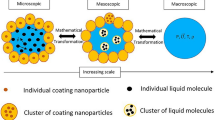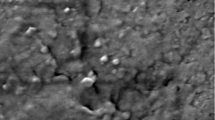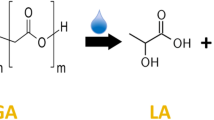Abstract
Beads are one of the particulate delivery systems used to achieve protection and/or controlled delivery of different active ingredients or microorganisms. Polyvinyl alcohol is a non-toxic and biodegradable polymer and possesses extensive applications as a biomaterial. In the present work, two different strategies were applied for the prediction of shape and size of polyvinyl alcohol beads. These beads were obtained by extrusion dripping of a boric acid–polyvinyl alcohol aqueous solution into a basic aqueous gelling bath. The shapes and sizes of immature, mature and dry beads were determined using optical microscopy. Two different strategies included statistical and fluid dynamical (mechanistic) models to fit the experimental data. The shape of immature and mature beads was found to be dependent on the viscosity of the dripping solution for the former and the maturation time for the latter. The shape of dry beads was found to be mainly dependent on the particle contraction in the drying process. The size of mature and dried beads was correctly predicted from the operating conditions by means of a statistically developed model and from the dripping solution properties by means of a fluid dynamical approach. The optimal conditions for minimal dried bead size were calculated. The obtained mathematical models allow reduction in the amount of resources and time taken in the initial stages of the development of a novel encapsulated formulation. The mechanistic model may be applied to other polymeric systems once the corresponding parameters have been determined during proof-of-concept experiments.






Similar content being viewed by others
Abbreviations
- [H3BO3/PVA]:
-
Boric acid to polyvinyl alcohol ratio, g H3BO3/100 g PVA
- [PVA]:
-
Polyvinyl alcohol concentration, %
- A b :
-
Area of the bead, mm2
- d b :
-
Equivalent diameter, mm
- d b,d :
-
Dried bead diameter, mm
- d b,i :
-
Immature bead diameter, mm
- d b,m :
-
Mature bead diameter, mm
- d b,t :
-
Bead diameter as obtained from Tate’s Law, mm
- d max :
-
Length of perpendicular major axis, mm
- d min :
-
Length of perpendicular minor axis, mm
- d o :
-
Outer needle diameter, mm
- F HB :
-
Harkins–Brown factor
- \( F_{\text{HB}}^{{{\text{H}}_{2} {\text{O}}}} \) :
-
Harkins–Brown factor for distilled water
- F snHB :
-
Harkins–Brown factor for polymeric solution
- g :
-
Gravity constant
- h :
-
Distance of flight, cm
- K D :
-
Drying factor
- K LF :
-
Liquid lost factor
- K SF :
-
Shrinkage factor
- \( m_{{{\text{H}}_{ 2} {\text{O}}}} \) :
-
Weight of a certain number of distilled water drops, g
- m sn :
-
Weight of a certain number of polymer solution drops, g
- Oh :
-
Ohnesorge number
- SF:
-
Sphericity factor
- SFb,d :
-
Dried bead sphericity factor
- SFb,i :
-
Immature bead sphericity factor
- SFb,m :
-
Mature bead sphericity factor
- V ideal :
-
Ideal volume of a drop detaching from the tip of a needle, mm3
- V real :
-
Real volume of a drop detaching from the tip of a needle, mm3
- μ sn :
-
Viscosity of the polymeric solution, cP
- ρ sn :
-
Density of the polymeric solution, kg/m3
- \( \sigma_{{{\text{H}}_{ 2} {\text{O}}}} \) :
-
Surface tension of bidistilled water, mN/m
- σ sn :
-
Surface tension of the polymeric solution, mN/m
References
Dintcheva NT, Catalano G, Arrigo R, Morici E, Cavallaro G, Lazzara G, Bruno M (2016) Pluronic nanoparticles as anti-oxidant carriers for polymers. Polym Degrad Stab 134:194–201
Zhang Z, Zhang R, Chen L, Tong Q, McClements DJ (2015) Designing hydrogel particles for controlled release of targeted release of lipophilic bioactive agents in the gastrointestinal tract. Eur Polym J 72:698–716
He H, Hong Y, Gu Z, Liu G, Cheng L, Li Z (2016) Improved stability and controlled release of CLA with spray-dried microcapsules of OSA-modified starch and xanthan gum. Carbohydr Polym 147:243–250
Savoji MT, Zhu XX (2015) Temperature- and pH-controlled encapsulation and release of guest molecules from invertible carriers. Polymer 68:35–40
Martins IM, Barreiro MF, Coelho M, Rodrigues AE (2014) Microencapsulation of essential oils with biodegradable polymeric carriers for cosmetic applications. Chem Eng J 245:191–200
Mitragotri S, Burke PA, Langer R (2014) Overcoming the challenges in administering biopharmaceuticals: formulation and delivery strategies. Nat Rev Drug Discov 13:655–672
Heinzen C, Berger A, Marison I (2004) Use of vibration technology for jet break-up for encapsulation of cells and liquids in monodisperse microcapsules. In: Nedović V, Willaert R (eds) Fundamentals of cell immobilisation biotechnology. Springer, Dordrecht, pp 257–275
DeMerlis CC, Schoneker DR (2003) Review of the oral toxicity of polyvinyl alcohol (PVA). Food Chem Toxicol 41:319–326
Baker MI, Walsh SP, Schwartz Z, Boyan BD (2012) A review of polyvinyl alcohol and its uses in cartilage and orthopedic applications. J Biomed Mater Res, Part B 100B:1451–1457
Hassan CM, Peppas NA (2000) Structure and applications of poly(vinyl alcohol) hydrogels produced by conventional crosslinking or by freezing/thawing methods. Biopolymers PVA Hydrogels, Anionic Polymerisation Nanocomposites. Springer Verlag, Berlin, pp 37–65
Anirudhan TS, Parvathy J, Nair AS (2016) A novel composite matrix based on polymeric micelle and hydrogel as drug carrier for the controlled release of dual drugs. Carbohydr Polym 136:1118–1127
Chang G, Chen Y, Li Y, Huang F, Shen Y, Xie A (2015) Self-healable hydrogel on tumor cell as drug delivery system for localized and effective therapy. Carbohydr Polym 122:336–342
Kaity S, Isaac J, Ghosh A (2013) Interpenetrating polymer network of locust beam gum-poly (vinylalcohol) for controlled release drug delivery. Carbohydr Polym 94:456–467
Luo Y, Luo G, Gelinsky M, Huang P, Ruan C (2017) 3D bioprinting scaffold using alginate/polyvinyl alcohol bioinks. Mater Lett 189:295–298
Yan E, Fan S, Li X, Wang C, Sun Z, Ni L, Zhang D (2013) Electrospun polyvinyl alcohol/chitosan composite nanofibers involving Au nanoparticles and their in vitro release properties. Mater Sci Eng C 33:461–465
Gu T, Liu X, Chai W, Li B, Sun H (2014) A preliminary research on polyvinyl alcohol hydrogel: a slowly-released anti-corrosion and scale inhibitor. J Pet Sci Eng 122:453–457
Rintoul I, Badano JM, Grau R (2014) Controlled-release injectable microparticle. USPatent 20140335193:A1
Ochiai H, Shimizu S, Tadokoro Y, Murakami I (1981) Complex formation between poly(vinyl alcohol) and borate ion. Polymer 22:1456–1458
Shibayama M, Yoshizawa H, Kurokawa H, Fujiwara H, Nomura S (1988) Sol-gel transition of poly(vinyl alcohol)-borate complex. Polymer 29:2066–2071
Jeong D, Cho K, Lee CH, Lee S, Bae H (2016) Integration of forward osmosis process and continuous airlift nitrifying bioreactor containing PVA/alginate-immobilized beads. Chem Eng J 306:1212–1222
Rahman AHA, Teo CL, Idris A, Misran E, Leong SAN (2016) Polyvinyl alcohol-alginate ferrophoto gels for mercury(II) removal. J Ind Eng Chem 33:190–196
Seker DC, Zain NAM (2014) Response surface optimization of glucose production from liquid pineapple waste using immobilized invertase in PVA-alginate-sulfate beads. Sep Purif Technol 133:48–54
Lee BB, Ravindra P, Chan ES (2013) Size and shape of calcium alginate beads produced by extrusion dripping. Chem Eng Technol 36:1627–1642
Chan ES, Lee BB, Ravindra P, Poncelet D (2009) Prediction models for shape and size of ca-alginate macrobeads produced through extrusion-dripping method. J Colloid Interface Sci 338:63–72
Lim GP, Lee BB, Ahmad MS, Singh H, Ravindra P (2016) Influence of process variables and formulation composition of sphericity and diameter of Ca-alginate-chitosan liquid core capsules prepared by extrusion dripping method. Part Sci Technol 34:681–690
Ong HY, Lee BB, Zakaria Z, Chang ES (2015) Diameter prediction mathematical models for xanthan gum-alginate capsules produced by extrusion-dripping method. In: AIP Conf Proc, vol 1660, pp 070034(1–6)
Lee BB, Chan ES, Ravindra P (2014) Calcium pectinate beads formation: shape and size analysis. J Eng Technol Sci 46:78–92
Lee BB, Bhandari BR, Howes T (2016) Air extrusion system for ionotropic alginate microgel particles formation: a review. Chem Eng Technol 39:2355–2369
Paulo BB, Ramos FM, Prata AS (2017) An investigation of operational parameters of jet cutting method on the size of Ca-alginate beads. J Food Process Eng 40:e12591. https://doi.org/10.1111/jfpe.12591
Dalmoro A, Barba AA, d’Amore M (2013) Analysis of size correlations for microdroplets produced by ultrasonic atomization. World Sci J 2013:1–7 (ID482910)
Lee BB, Ravindra P, Chan ES (2009) New drop weight analysis for surface tension determination of liquids. Colloids Surf A 332:112–120
Bhattacharya A, Ray P (2004) Studies on surface tension of poly(vinyl alcohol): effect of concentration, temperature, and addition of chaotropic agents. J Appl Polym Sci 93:122–130
Rošic R, Pelipenko J, Kristl J, Kocbek P, Bešter-Rogač M, Baumgartner S (2013) Physical characteristics of poly (vinyl alcohol) solutions in relation to electrospun nanofiber formation. Eur Polym J 49:290–298
Shibayama M, Sato M, Kimura Y, Fujiwara H, Nomura S (1988) 11B n.m.r. study on the reaction of poly(vinyl alcohol) wit boric acid. Polymer 29:336–340
Wu KYA, Wisecarver KD (1992) Cell immobilization using PVA crosslinked with boric acid. Biotechnol Bioeng 39:447–449
Li ZQ, Hou LD, Li Z, Zheng W, Li L (2013) Study on shape optimization of calcium-alginate beads. Adv Mater Res 648:125–130
Acknowledgements
The authors thank the Consejo Nacional de Investigaciones Científicas y Técnicas and the Instituto de Promoción de la Carne Vacuna Argentina for their financial support.
Author information
Authors and Affiliations
Corresponding author
Ethics declarations
Conflict of interest
The authors declare that they have no conflict of interest.
Electronic supplementary material
Below is the link to the electronic supplementary material.
Rights and permissions
About this article
Cite this article
Weibel, M.I., Mengatto, L.N., Luna, J.A. et al. Accurate prediction of shape and size of polyvinyl alcohol beads produced by extrusion dripping. Iran Polym J 27, 161–170 (2018). https://doi.org/10.1007/s13726-017-0597-y
Received:
Accepted:
Published:
Issue Date:
DOI: https://doi.org/10.1007/s13726-017-0597-y




